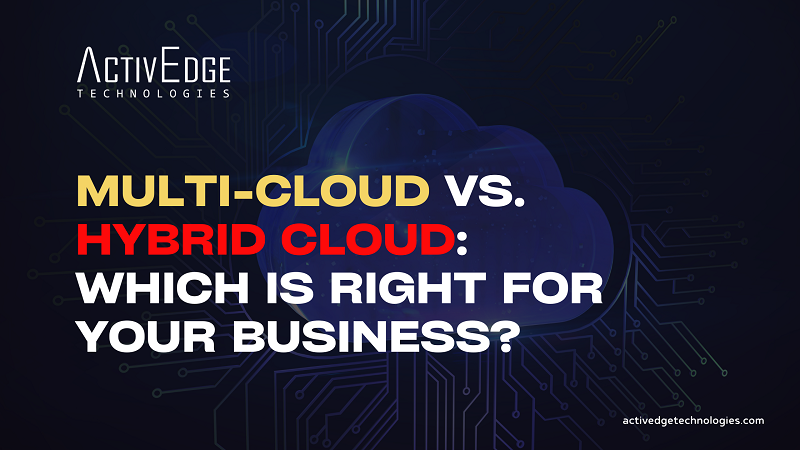Multi-cloud vs. hybrid cloud: Which is right for your business?
With more organizations moving their operations into the cloud, and the need to scale safely and effectively grows, companies are increasingly looking to multiple cloud solutions. Using multiple cloud platforms helps manage and accommodate different types of data loads, and increases optimization of IT operations. For many enterprises, the question is not
whether they need a solution involving more than one cloud–but rather, which one would work best for their needs
By using different cloud providers for different workloads, organizations can optimize their
resource usage and reduce costs. Having several cloud providers also helps organizations
avoid being boxed into unwanted service limitations, or other issues that may arise from
vendor-specific changes or policies.
The two types of multiple cloud solutions are multi-cloud and hybrid cloud. And while the
solutions are similar and the terms are sometimes used interchangeably, they are distinct
platforms with their own benefits and challenges.
Multi-cloud deployments may be the right solution for you if:
You need greater resilience and redundancy. Multi-cloud deployments can provide
resilience and redundancy by distributing workloads across multiple cloud providers. In case
of a cloud provider outage, traffic can be redirected to the other cloud providers, ensuring
minimal downtime and disruption.
You want to optimize costs over time. Multi-cloud deployments can help organizations
optimize their cloud costs by selecting the most cost-effective cloud provider for each
workload. Different cloud providers have different pricing models and cost structures, so by
choosing the right provider for each workload, organizations can save money and improve
their ROI.
You want to boost data sovereignty and compliance. Multi-cloud deployments can help
organizations address data sovereignty and compliance requirements by selecting cloud
providers that offer data residency in specific regions and comply with relevant regulations.
By leveraging multiple cloud providers, organizations can ensure that their data is stored and
processed in compliance with applicable laws and regulations.
Your organization has varying demands for speed, demand, or traffic. Depending on your
needs, you can scale a multi-cloud system up or down. A hybrid-cloud system might be more
challenging.
Your users (employees and customers) are globally distributed. Having a geographically
spread-out work force or customer base means that a multi-cloud solution spread over
several regions could be more effective.
Example of a company successfully using a multi-cloud solution: Trintech
Trintech, a software-as-a-service (SaaS) provider, found that working with several cloud
service providers turned out to be a smart move. According to Fortune, the company has
been able to enter markets at a lower price point or scale at a better price point by picking
the best provider for specific needs. The company, which helps enterprise and mid-market
companies to automate and improve efficiency, discovered the advantages of public clouds’
flexibility and operational cost.
Hybrid cloud solutions may work better for you if:
You want to focus on agility. The primary advantage of a hybrid cloud is agility: Organizations can scale compute resources up and down according to need, and choose where workloads are processed based on requirements for data security or workload sensitivity. Organizations can migrate and manage workloads between cloud environments to optimize processing flexibility, cost, and control based on specific business or regulatory requirements.
You need to meet regulatory or compliance requirements. Certain regulations or compliance requirements may require businesses to use specific cloud providers or to keep data in specific geographic locations (for instance, the data residency provisions of the EU’s General Data Protection Regulation or GDPR). Multi-cloud can allow businesses to meet these requirements while still taking advantage of the benefits of cloud computing.
Your organization wants more control over frequently used or sensitive data. Organizations often choose to store frequently accessed or sensitive data on a private cloud or in on-premises storage to ensure greater control and security, though this may require more upfront investment in infrastructure. Less frequently accessed data can be stored on the public cloud.
Your company requires near-real-time information exchange. Although multi-cloud
deployments can achieve very low latency to meet the demands of most workloads.
Example of a company successfully using a hybrid cloud: Hulu
Hulu uses a hybrid cloud model to store and manage its library of video content and handle
spikes in viewing demand. It uses a public cloud provider to organize its content catalog and
to track users, their preferences, what they watch, and what they click on. However, to reduce
latency and ensure high-quality streaming, and to manage its on-demand and pay-per-view
features, it also uses a private cloud
Harnessing the power of multi-cloud or hybrid cloud
Using multiple clouds is increasingly the path for organizations seeking to easily scale their
operations and manage their data in an ever-more-complex world. A company can choose to use a multi-cloud solution, and move all its data and operations to public clouds. Or it
may decide that a hybrid cloud solution, which uses one or more public clouds along with
a company’s own private cloud or data center. Both solutions add flexibility, availability, and
scalability to operations; a company just needs to decide which one best suits their business
and data security needs.
Let our experts take your cloud security worries off your shoulders, so you can
get down to business. Visit https://activedgetechnologies.com
Give us a call on +234 906 844 4440
Contact [email protected] to learn more or to schedule a demo.

